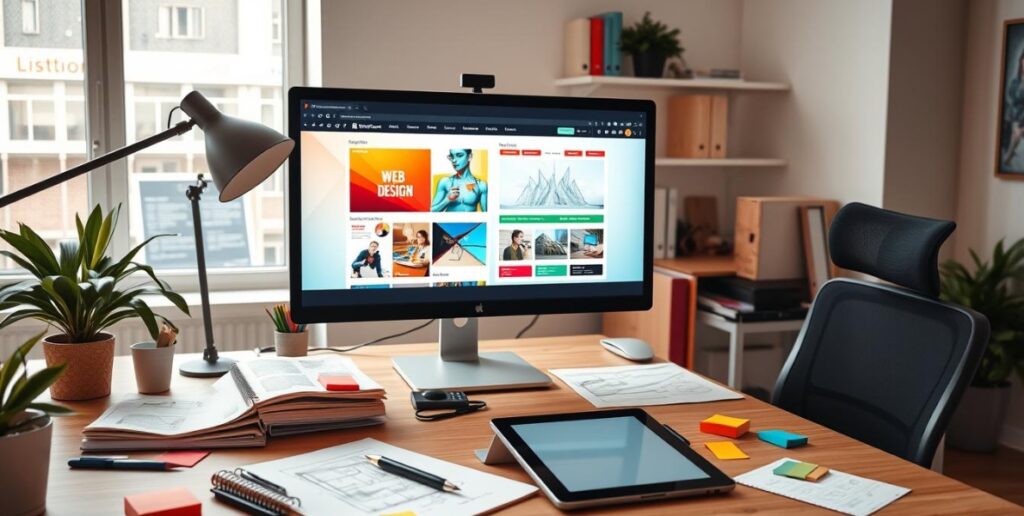Imagine sitting in front of your computer, feeling lost about making a website for your business, or wondering what web designers do. The empty digital space seems daunting. That’s when web designers come in, turning your digital dreams into reality. Let’s explore how these creative minds can enhance your online presence and help your business grow.
Web designers are the architects of the internet, creating websites that are both beautiful and functional. They go beyond just making things look good. They mix art with technical skills, making websites easy to use. From design elements to navigation, web designers shape your online brand.
So, what makes web designers different from other digital experts? Unlike web developers, who mainly focus on coding, web designers concentrate on the visual and interactive parts of websites. They make sure your site works well on all devices.
At DiviCode, we focus on creating websites that rank high on search engines, such as Google while offering a great user experience.
Key Takeaways
- Web designers combine creativity and technical skills to build engaging websites
- They focus on visual design, user experience, and brand consistency
- Web design differs from web development, though some overlap exists
- Effective web design can significantly impact a business’s online success
- Collaboration with web designers can maximize your website’s potential
Understanding the Core Functions of Web Design
Web design is all about making websites that look good and work well. It’s about creating web pages that users enjoy and that help businesses succeed.
Visual Design and User Interface Creation
Visual design is the starting point for any website. It’s about picking colors, fonts, and images that match the brand. A good UX designer makes interfaces that look great and are easy to use.
They design buttons, forms, and other things users interact with. This makes the website fun and functional.
Website Layout and Navigation Planning
Good layout and navigation are key to a website’s success. Designers organize web pages in a way that makes sense. They create menus, sidebars, and footers to help users find what they need fast.
This planning stage often starts with wireframing. It helps designers see the site’s structure before getting into the details.
User Experience Optimization
User experience is at the heart of web design. Designers use design principles to make websites that look good and are easy to use. This means:
- Streamlining user flows
- Optimizing page load times
- Ensuring accessibility for all users
- Creating responsive designs for various devices
By focusing on these areas, web designers make sites that attract visitors and help businesses grow. The mix of looks, usability, and user experience is what makes web design effective.
What Web Designers Do: Essential Roles and Responsibilities
Web designers are key in shaping websites. They mix creativity with technical skills in their work and design elements. Let’s look at the main tasks they handle.

At the heart of web design is making websites that look good and work well. Designers pick colors, fonts, and layouts that match a brand. They also make sure websites are easy to use.
Good communication is crucial for designers. They work with clients, developers, and others. They turn client ideas into designs and keep everyone updated on the project.
| Design Work | Technical Tasks | Client Interaction |
|---|---|---|
| Creating wireframes | Coding in HTML/CSS | Gathering requirements |
| Developing prototypes | Optimizing for mobile | Presenting design concepts |
| Crafting visual elements | Testing across browsers | Incorporating feedback |
Web designers work on many parts of website making, from start to finish. They keep up with new design trends and tech. This is key to their job.
“Good design is obvious. Great design is transparent.” – Joe Sparano
In short, web designers are the digital architects. They mix beauty with function to make online experiences great. Their skills and creativity are vital in today’s digital world.
Technical Skills and Tools in Modern Web Design

Web design has changed a lot, needing many technical skills and tools. Today, web designers must know a lot of design software and coding languages. They need to make websites that not only look great, but also work well.
Design Software Proficiency Requirements
Knowing web design software is very important. Designers use graphic design software to make visual parts. Then, they use web design software to make these parts work on the web.
| Software Type | Popular Tools | Primary Use |
|---|---|---|
| Graphic Design | Adobe Photoshop, Illustrator, Canva | Image editing, vector graphics |
| Web Design | Adobe XD, Sketch | UI/UX design, wireframing |
| Prototyping | InVision, Figma | Interactive prototypes |
Coding Languages and Development Basics

Knowing coding languages is key for web designers. HTML and CSS are the basics. JavaScript makes things interactive. This knowledge helps designers work well with developers and create more complex designs.
Understanding frameworks and libraries such as Bootstrap for responsive design or React.js for dynamic user interfaces can significantly enhance a designer’s skill set. Familiarity with version control systems like Git is also beneficial, as it allows designers to collaborate more effectively with developers and manage changes to their projects.
Prototyping and Wireframing Tools
Prototyping tools let designers see and test designs before they’re made. These tools help make changes fast and get feedback from clients. Knowing these technical skills and tools is crucial for success in web design today.
Awareness of UX/UI principles is also crucial for creating user-friendly interfaces. This includes understanding user behavior, accessibility standards, and the importance of mobile-first design. Designers who can integrate these principles with their coding knowledge can build websites that are not only visually appealing but also functional and accessible to a wider audience.
Keeping up with emerging technologies and trends in web design, such as progressive web apps (PWAs), motion design, and the use of artificial intelligence in design processes, can set a designer apart in a competitive landscape. Continuous learning and adaptation are essential in the ever-evolving field of web design, ensuring that designers remain relevant and proficient in their craft.
The Web Design Process from Concept to Launch

The web design process turns ideas into websites that are both functional and beautiful. Our team uses a clear plan to make sure every project meets the client’s needs and what users want.
Project Planning and Client Communication
We start each project with a detailed plan. We learn about the client’s goals, who they want to reach, and their brand. We keep in touch with clients to keep them updated and involved.
Design Implementation and Testing
Our designers use top tools to make ideas real. They create mockups, prototypes, and wireframes to show the site’s layout and how it works. We test it a lot to make sure it works well on all devices and browsers.
Responsive Design and Mobile Optimization
Today, making websites work on mobile is key. We make sure websites look good and work well on phones, tablets, and computers. This makes users happy and helps websites rank better in search results.
| Design Phase | Key Activities | Deliverables |
|---|---|---|
| Planning | Client meetings, research | Project brief, timeline |
| Implementation | Wireframing, prototyping | Visual designs, functional prototypes |
| Optimization | Responsive testing, performance tuning | Mobile-friendly site, speed reports |
By using this detailed web design process, we make websites that look amazing and work great on all devices.
Collaborating with Web Designers: Best Practices

Working well with web designers is crucial. To make a web project succeed, clear communication and setting expectations are key.
Web designers and developers team up to make your idea real. Here are some tips for a smooth partnership:
- Clearly define project goals and timelines
- Provide detailed feedback on design concepts
- Be open to professional suggestions and insights
- Schedule regular check-ins to track progress
Keep talking openly with web developers during the project. This helps solve problems fast and keeps everyone on the same page.
“The key to a successful web project is clear communication and mutual respect between clients and designers.”
Designers work with others too. A team that works together can come up with new ideas and a better final product.
| Collaboration Aspect | Client Role | Designer Role |
|---|---|---|
| Project Planning | Define goals and requirements | Provide timeline and resource estimates |
| Design Process | Offer timely feedback | Present multiple design concepts |
| Development | Test and review progress | Implement designs and functionality |
| Launch | Final approval and content provision | Ensure site optimization and responsiveness |
By following these tips, you’ll have a great partnership. This will lead to a web project that meets your vision and user needs.
Maximizing ROI When Working with Web Design Professionals

Working with expert web designers can really boost your online presence. To get the most out of your investment, it’s key to plan strategically. Let’s look at how to maximize your return on investment (ROI) when working with web design pros.
Setting Clear Project Goals and Expectations
First, decide what you want your website to do. Do you want to sell more, get leads, or boost your brand? Tell your web designer what you aim for. This makes it easier for both new and experienced designers to meet your needs.
Setting clear project goals and expectations is crucial for success in a web design project. A graphic designer must communicate effectively with the design team to ensure that all web designers focus on the desired visual aspects of websites and the overall feel of a website.
According to the Bureau of Labor Statistics, many freelance web designers or website designers may have varying job descriptions. A senior web designer typically oversees the design and development process, while entry-level web designers often learn web design fundamentals alongside UI designers and visual designers.
To achieve cohesive web design work, freelance web designers and web designers will also need to collaborate closely, ensuring their designs align with project goals. By establishing these objectives early on, a designer needs to focus on delivering effective web design services that meet client expectations.
Budget Planning and Resource Allocation
Figure out how much you can spend on your web design. The price a web designer charges depends on their experience and the project’s complexity. Spend your budget on features that match your goals. This way, you get the best value, whether you’re working with top designers or newcomers.
Budget planning and resource allocation are crucial for any web designer job. A web designer is responsible for creating a professional website or web application. Many web designers tend to focus on the visual aspects, using digital design principles to design the layout effectively.
In the web design and development process, web designers work closely with web developers. The web design role involves understanding web design theory and applying it to create user-friendly interfaces. As a web designer, one may also engage in design vs functionality discussions, ensuring that the designer is responsible for creating a balance between aesthetics and usability.
Overall, web designers need to plan their projects carefully, considering both budget planning and the resources available. A job as a web designer often requires collaboration and flexibility, as web designers use various tools and technologies to achieve their goals in web design and web development.
Measuring Design Success and Performance
After your site goes live, watch its performance with analytics tools. Look at traffic, conversion rates, and how users interact with your site. This data shows if your design is working and guides future improvements. By tracking success, you can keep making your online presence better and get more from your web design investment.
FAQ About What Web Designers Do

What is the primary role of a web designer?
The primary role of a web designer is to create visually appealing and functional websites. They focus on the layout, color scheme, typography, and overall aesthetics of a website. Web designers often collaborate with web developers and digital designers to ensure that the design is not only attractive but also user-friendly. Their work involves understanding the needs of the client and translating those into a digital format that enhances user engagement and meets business goals.
What skills should a web designer possess?
A successful web designer should possess a combination of technical and soft skills. Key skills include proficiency in design software such as Adobe Creative Suite, knowledge of ux design principles, and an understanding of web development languages such as HTML, CSS, and JavaScript. Additionally, communication skills are crucial as designers may need to articulate their ideas and collaborate with clients and other team members effectively.
How do designers create a user-friendly website?
Designers create user-friendly websites by focusing on user experience design (UX). This involves researching user behaviors and preferences, creating wireframes and prototypes, and conducting usability testing. By prioritizing the needs and expectations of users, they ensure the website is intuitive and easy to navigate, which enhances overall satisfaction and engagement.
What is the difference between a web designer and a web developer?
The difference between a web designer and a web developer lies in their focus areas. While web designers concentrate on the visual and functional aspects of a website, web developers and digital designers are responsible for the technical implementation of those designs. Developers write the code that makes the website operational, ensuring that it functions correctly across different platforms and devices.
Can I become a web designer without a formal degree?
Yes, it is possible to become a web designer without a formal degree. Many successful designers are self-taught or have completed online courses and boot camps. What matters most is building a strong portfolio that showcases your skills and understanding of design and web principles. Aspiring web designers should focus on learning the necessary tools, techniques, and best practices to create effective websites.




0 Comments